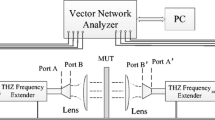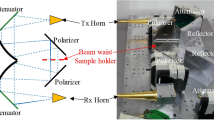Abstract
Dielectric materials play a supporting role for electronic circuits. With the development of 5G millimeter wave communication, precision measurement of dielectric property becomes increasingly important. This paper introduces a free-space quasi-optical spectroscopy for complex dielectric property measurement. This spectroscopy can work in both transmission and reflection modes to accommodate both low-loss and high-loss materials. By applying the transfer matrix theory, both solid and liquid samples can be characterized using this system. In addition, the system employs a Gaussian telescope design, giving a possibility of broadband operation. Furthermore, this system is much simpler in calibration compared to other systems. A detailed description of the quasi-optical system is presented. Four materials are measured in the E-band (60–90 GHz). De-ionized water is also measured to represent liquid substrates in electronic circuits. The measurement is in good agreement with published data within a discrepancy of 5%.











Similar content being viewed by others
References
X. Wu, C.-X. Wang, J. Sun, J. Huang, R. Feng, Y. Yang, and X. Ge, “60-GHz millimeter-wave channel measurements and modeling for indoor office environments,” IEEE Trans. Antenna Propag., 65, 1912-1924(2017).
J. Hasch, E. Topak, R. Schnabel, Zwick R, T. Weigel, and C. Waldschmidt, “Millimeter-wave technology for automotive radar sensors in the 77 GHz frequency band,” IEEE Trans. Microw. Theory, 60, 845-860(2012).
N. A. Salmon, “Outdoor passive millimeter-wave imaging: phenomenology and scene simulation,” IEEE Trans. Antenna Propag., 66, 897-908(2018).
K.-F. Lee, S. R. Chebolu, W. Chen,R. Q. Lee, “On the role of substrate loss tangent in the cavity model theory of microstrip patch antennas,” IEEE Trans. Antenna Propag., 42, 110-112(1994).
A. J. Jaworski and G. T. Bolton, “The design of an electrical capacitance tomography sensor for use with media of high dielectric permittivity,” Meas. Sci. Technol., 11, 743-757(2000).
J. Baker, E. J. Vanzura, and W. A. Kissick, “Improved technique for determining complex permittivity with the transmission/reflection method,” IEEE Trans. Microw. Theory, 38, 1096-1103(1990).
M. A. Stuchly and S. S. Stuchly, “Coaxial line reflection methods for measuring dielectric properties of biological substances at radio and microwave frequencies-a review,” IEEE Trans. Instrum. Meas., IM-29, 176-183(1980).
D. K. Ghodgaonkar, V. V. Varadan, V. K. Varadan, “Free-space measurement of complex permittivity and complex permeability of magnetic materials at microwave frequencies,” IEEE Trans. Instrum. Meas., 39, 387-394(1990).
J. Sheen, “Microwave measurements of dielectric properties using a closed cylindrical cavity dielectric resonator,” IEEE Trans. Dielect Elect. Insul., 14, 1139-1144(2007).
X. Liu, J. Yu, “Characterization of the dielectric properties of water and methanol in the D-band using a quasi-optical spectroscopy,” Sci. Rep., 9, 18562(2019).
J. R. Peacock, “Millimetre wave permittivity of water near 25 °C,” J. Phys. D Appl. Phys., 42, 205501(2009).
A. Ha, M. H. Chae, K. Kim, “Beamwidth control of an impulse radiating antenna using a liquid metal reflector,” IEEE Antennas Wirel. Propag. Lett., 18, 571-575(2019).
E. Polat, R. Reese, M. Jost, C. Schuster, M. Nickel, R. Jakoby, H. Maune, “Tunable liquid crystal filter in nonradiative dielectric waveguide technology at 60 GHz,” IEEE Microw. Wirel. Compon. Lett., 29, 44-46(2019).
P. F. Goldsmith, Quasioptical systems: Gaussian beam quasioptical propogation and applications (Wiley-IEEE Press, New York, 1998).
Y. Wang and Z. Shi, “Millimeter-wave mobile communication,” in W. Xiang (ed.), K. Zheng (ed.), X. (Sherman) Shen (ed.), 5G Mobile Communications. Springer International Publishing, 2016. doi: https://doi.org/10.1007/978-3-319-34208-5_5.
C. K. Campbell. “Free-space permittivity measurements on dielectric materials at millimeter wavelengths,” IEEE Trans. Instrum. Meas., 27, 54-58(1978).
J. A. Murphy. “Distortion of a simple Gaussian beam on reflection from off-axis ellipsoidal mirrors,”. Int. J Infrared Milli. Waves 8, 1165-1187 (1987).
C. A. Balanis, Advanced Engineering Electromagnetics, Chapter 5 (Wiley, New York, 1989).
Bin Yang, Assessment of magnetic material for use in quasi-optical non-reciprocal devices operating at frequencies above 90 GHz, PhD Thesis, Department of Electronic Engineering, Queen Mary University of London, London, UK, (2008).
A.-H. Boughriet, C. Legrand, A. Chapoton, “Noniterative stable transmission/reflection method for low-loss material complex permittivity determination,” IEEE Trans. Microw. Theory, 45, 52-57(1997).
S. Szwarnowski, R. J. Sheppard, “Precision waveguide cells for the measurement of permittivity of lossy liquids at 70 GHz,” J. Phys. E: Sci. Instrum., 10, 1163-1167(1977).
H. V. Chekalin, M. I. Shakhparonov, “The mechanism of dielectric relaxation in water,” J. Struct. Chem., 9, 789-790(1968).
H. J. Liebe, G. A. Hufford, T. Manabe, “A model for the complex permittivity of water at frequencies below 1 THz,” J. Infrared Millim., 12, 659-675(1991).
N. Gagnon, J. Shaker, P. Berini, L. Roy, A. Petosa, “Material characterization using a quasi-optical measurement system,” IEEE Trans. Instrum. Meas., 52, 333-336(2003).
D. Bourreau, A. Péden, S. Le Maguer, “A quasi-optical free-space measurement setup without time-domain gating for material characterization in the W-band,” IEEE Trans. Instrum. Meas., 55, 2022-2028,(2006).
S. Chen, K. A. Korolev, J. Kupershmidt, K. Nguyen, M. N. Afsar, “High-resolution high-power quasi-optical free-space spectrometer for dielectric and magnetic measurements in millimeter waves,” IEEE Trans. Instrum. Meas., 58, 2671-2678(2009).
T. Tosaka, K. Fujii, K. Fukunaga, A. Kasamatsu, “Development of complex relative permittivity measurement system based on free-space in 220–330 GHz range,” IEEE Trans. Terahertz Sci. Technol., 5, 102-109(2015).
A. Kazemipour, M. Hudlička, S.-K. Yee, M. Hudlička, M. Salhi, T. Kleine-Ostmann, T. Schrader, “Design and calibration of a compact quasi-optical system for material characterization in millimeter/sub-millimeter wave domain,” IEEE Trans. Instrum. Meas., 64, 1438-1445(2015).
J. Hammler, A. J. Gallant, C. Balocco, “Free-space permittivity measurement at terahertz frequencies with a vector network analyzer,” IEEE Trans. Terahertz Sci. Technol., 6, 817-823(2016).
A. M. Hassan, J. Obrzut, E. J. Garboczi, “A Q-band free-space characterization of carbon nanotube composites,” IEEE Trans. Microw. Theory, 64, 3807-3819(2016).
L. Oberto, M. Bisi, A. Kazemipour, A. Steiger, T. Kleine-Ostmann, T. Schrader, “Measurement comparison among time-domain, FTIR and VNA-based spectrometers in the THz frequency range,” Metrologia, 54, 77-84(2017).
T. Horák, G. Ducournau, M. Micica, K. Postava, J. B. Youssef, J.-F. Lampin, M. Vanwolleghem, “Free-space characterization of magneto-optical hexaferrites in the submillimeter-wave range,” IEEE Trans. Terahertz Sci. Technol., 7, 563-571(2017).
E. Hajisaeid, A. F. Dericioglu, and A. Akyurtlu, “All 3-D printed free-space setup for microwave dielectric characterization of materials,” IEEE Trans. Instrum. Meas., 67,1877-1886(2018).
J. A. Murphy, S. Withington, “Perturbation analysis of Gaussian-beam-mode at off-axis ellipsoidal mirrors,” Infrared Phys. Technol., 37, 205-219(1996).
Funding
This work is supported by the National Natural Science Foundation of China under the contract number of 61871003.
Author information
Authors and Affiliations
Corresponding author
Additional information
Publisher’s Note
Springer Nature remains neutral with regard to jurisdictional claims in published maps and institutional affiliations.
Rights and permissions
About this article
Cite this article
Liu, X., Yu, S., Gan, L. et al. Broadband Quasi-Optical Dielectric Spectroscopy for Solid and Liquid Samples. J Infrared Milli Terahz Waves 41, 810–824 (2020). https://doi.org/10.1007/s10762-020-00710-5
Received:
Accepted:
Published:
Issue Date:
DOI: https://doi.org/10.1007/s10762-020-00710-5




